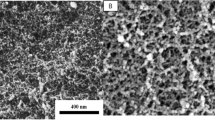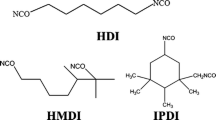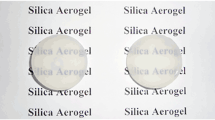Abstract
The high toxicity/volatility and low biodegradation of phenolic compounds are serious concerns in terms of environmental and health impact—their recommended max. value for drinking water is 0.005 mg/L. They are usually removed from effluents by adsorption, but they show a complex interaction behavior with adsorbents, because the hydroxyl group and the hydrophobic aromatic ring are very close. In this work, the versatility of Si chemistry was explored to tailor the surface chemistry of silica aerogels and improve their adsorption performance towards phenolic compounds. Methyltrimethoxysilane and tetramethylorthosilicate were combined to adjust the hydrophobicity of the obtained aerogels. In the next stage, β-cyclodextrin, with its highly hydrophobic cavity, was grafted into the gels to improve the capturing of aromatic rings. For a sustainable linkage of β-cyclodextrin to silica, the methyltrimethoxysilane/tetramethylorthosilicate precursor system was modified by adding an epoxy functionalized silane. A first screening of the adsorption performance shows a 1.5–2-fold increase of the adsorption capacity and removal efficiencies of the epoxy-cyclodextrin-modified aerogel toward phenol and p-cresol when compared to aerogel counterpart without modification. Freundlich isotherm model was the most suitable to describe the equilibrium data of aerogels with or without β-cyclodextrin, with the curves showing favorable profiles, more evident in the case of aerogels with β-cyclodextrin. Apart from the improving of the sorption capacity for phenolic compounds (achieving a maximum of 60 mg g−1 in the case of p-cresol), the utilization of the biodegradable β-cyclodextrin moiety obtained from natural and sustainable resources is a further asset of the epoxy-cyclodextrin-modified aerogel.
Graphical Abstract








Similar content being viewed by others
References
Dąbrowski A, Podkościelny P, Hubicki Z, Barczak M (2005) Adsorption of phenolic compounds by activated carbon - a critical review. Chemosphere 58(8):1049–1070. doi:10.1016/j.chemosphere.2004.09.067
Michałowicz J, Duda W (2007) Phenols - Sources and toxicity. Pol J Environ Stud 16(3):347–362
Busca G, Berardinelli S, Resini C, Arrighi L (2008) Technologies for the removal of phenol from fluid streams: a short review of recent developments. J Hazard Mater 160:265–288. doi:10.1016/j.jhazmat.2008.03.045
Fang HH, Chan OC (1997) Toxicity of phenol towards anaerobic biogranules. Water Res 31(9):2229–2242
Polat H, Molva M, Polat M (2006) Capacity and mechanism of phenol adsorption on lignite International. J Miner Process 79:264–273. doi:10.1016/j.minpro.2006.03.003
Cermola F, DellaGreca M, Iesce M, Montella S, Pollio A, Temussi F (2004) A mild photochemical approach to the degradation of phenols from olive oil mill wastewater. Chemosphere 55:1035–1041. doi:10.1016/j.chemosphere.2003.12.016
Dursun G, Çiçek H, Dursun AY (2005) Adsorption of phenol from aqueous solution by using carbonized beet pulp. J Hazard Mater 125:175–182. doi:10.1016/j.jhazmat.2005.05.023
Aksu Z, Yener J (2001) A comparative adsorption/biosorption study of mono-chlorinated phenols onto various sorbents. Waste Manage 21:695–702. doi:10.1016/S0956-053X(01)00006-X
Bernardo M, Santos A, Cantinho P, Minhalma M (2011) Cork industry wastewater partition by ultra/nanofiltration: A biodegradation and valorisation study. Water Res 45:904–912. doi:10.1016/j.watres.2010.09.027
Justino CI, Duarte K, Loureiro F, Pereira R, Antunes SC, Marques SM, Gonçalves F, Rocha-Santos TA, Freitas AC (2009) Toxicity and organic content characterization of olive oil mill wastewater undergoing a sequential treatment with fungi and photo-Fenton oxidation. J Hazard Mater 172(2–3):1560–1572. doi:10.1016/j.jhazmat.2009.08.028
Özkaya B (2006) Adsorption and desorption of phenol on activated carbon and a comparison of isotherm models. J Hazard Mater 129:158–163. doi:10.1016/j.jhazmat.2005.08.025
Hameed B, Rahman A (2008) Removal of phenol from aqueous solutions by adsorption onto activated carbon prepared from biomass material. J Hazard Mater 160:576–581. doi:10.1016/j.jhazmat.2008.03.028
Liu Q-S, Zheng T, Wang P, Jiang J-P, Li N (2010) Adsorption isotherm, kinetic and mechanism studies of some substituted phenols on activated carbon fibers. Chem Eng J 157(2–3):348–356. doi:10.1016/j.cej.2009.11.013
Zeng X, Fan Y, Wu G, Wang C, Shi R (2009) Enhanced adsorption of phenol from water by a novel polar post-crosslinked polymeric adsorbent. J Hazard Mater 169:1022–1028. doi:10.1016/j.jhazmat.2009.04.044
Ming ZW, Long CJ, Cai PB, Xing ZQ, Zhang B (2006) Synergistic adsorption of phenol from aqueous solution onto polymeric adsorbents. J Hazard Mater 128:123–129. doi:10.1016/j.jhazmat.2005.03.036
An F, Gao B, Feng X (2009) Adsorption mechanism and property of novel composite material PMAA/SiO2 towards phenol. Chem Eng J 153:108–113. doi:10.1016/j.cej.2009.02.040
Dias JM, Alvim-Ferraz MC, Almeida MF, Rivera-Utrilla J, Sánchez-Polo M (2007) Waste materials for activated carbon preparation and its use in aqueous-phase treatment: a review. J Environ Manage 85:833–846. doi:10.1016/j.jenvman.2007.07.031
Štandeker S, Novak Z, Knez Ž (2007) Adsorption of toxic organic compounds from water with hydrophobic silica aerogels. J Colloid Interface Sci 310:362–368. doi:10.1016/j.jcis.2007.02.021
Lin S-H, Juang R-S (2009) Adsorption of phenol and its derivatives from water using synthetic resins and low-cost natural adsorbents: a review. J Environ Manage 90:1336–1349. doi:10.1016/j.jenvman.2008.09.003
Maleki H (2016) Recent advances in aerogels for environmental remediation applications: a review. Chem Eng J 300:98–118. doi:10.1016/j.cej.2016.04.098
Gurav JL, Jung I-K, Park H-H, Kang ES, Nadargi DY (2010) Silica Aerogel: Synthesis and Applications. J Nanomater 2010:1–11. doi:10.1155/2010/409310
Aegerter MA, Leventis N, Koebel MM (2011) Aerogels Handbook (Advances in Sol-Gel Derived Materials and Technologies). Springer. doi:10.1007/978-1-4419-7589-8
Durães L, Ochoa M, Rocha N, Patrício R, Duarte N, Redondo V, Portugal A (2012) Effect of the drying conditions on the microstructure of silica based xerogels and aerogels. J Nanosci Nanotechnol 12(8):6828–6834. doi:10.1166/jnn.2012.4560
Soleimani Dorcheh A, Abbasi MH (2008) Silica aerogel; synthesis, properties and characterization. J Mater Process Technol 199(1–3):10–26. doi:10.1016/j.jmatprotec.2007.10.060
Maleki H, Durães L, Portugal A (2014) An overview on silica aerogels synthesis and different mechanical reinforcing strategies. J Non-Cryst Solids 385:55–74. doi:10.1016/j.jnoncrysol.2013.10.017
Sani S, Muhid MNM, Hamdan H (2011) Design, synthesis and activity study of tyrosinase encapsulated silica aerogel (TESA) biosensor for phenol removal in aqueous solution. J Sol–Gel Sci Technol 59:7–18. doi:10.1007/s10971-011-2454-3
Perdigoto M, Martins R, Rocha N, Quina M, Gando-Ferreira L, Patrício R, Durães L (2012) Application of hydrophobic silica based aerogels and xerogels for removal of toxic organic compounds from aqueous solutions. J Colloid Interface Sci 380:134–140. doi:10.1016/j.jcis.2012.04.062
Wu Z, Ahn I-S, Lee C-H, Kim J-H, Shul YG, Lee K (2004a) Enhancing the organic dye adsorption on porous xerogels. Colloids Surf A: Physicochem Eng Aspects 240:157–164. doi:10.1016/j.colsurfa.2004.04.045
Wu Z, Joo H, Ahn I-S, Haam S, Kim J-H, Lee K (2004b) Organic dye adsorption on mesoporous hybrid gels. Chem Eng J 102:277–282. doi:10.1016/j.cej.2004.05.008
Wu Z, You L, Xiang H, Jiang Y (2006) Comparison of dye adsorption by mesoporous hybrid gels: Understanding the interactions between dyes and gel surfaces. J Colloid Interface Sci 303:346–352. doi:10.1016/j.jcis.2006.08.018
You L, Wu Z, Kim T, Lee K (2006) Kinetics and thermodynamics of bromophenol blue adsorption by a mesoporous hybrid gel derived from tetraethoxysilane and bis(trimethoxysilyl)hexane. J Colloid Interface Sci 300:526–535. doi:10.1016/j.jcis.2006.04.039
Haghbeen K, Legge RL (2009) Adsorption of phenolic compounds on some hybrid xerogels. Chem Eng J 150:1–7. doi:10.1016/j.cej.2008.11.036
Wei W, Zhang J, Wu L, Qin G (2012) Effects of preparation conditions on characters of hydrophobic silica granular aerogel and its applications. Adv Mater Res 600:190–193. doi:10.4028/www.scientific.net/AMR.600.190
Qin G, Yao Y, Wei W, Zhang T (2013) Preparation of hydrophobic granular silica aerogels and adsorption of phenol from water. Appl Surf Sci 280:806–811. doi:10.1016/j.apsusc.2013.05.066
Firoozmandan M, Moghaddas J, Yasrebi N (2016) Performance of water glass-based silica aerogel for adsorption of phenol from aqueous solution. J Sol-Gel Sci Technol 79:67–75. doi:10.1007/s10971-016-4007-2
An F, Gao B (2008) Adsorption of phenol on a novel adsorption material PEI/SiO2. J Hazard Mater 152:1186–1191. doi:10.1016/j.jhazmat.2007.07.102
An F, Gao B, Feng X (2008) Adsorption and recognizing ability of molecular imprinted polymer MIP-PEI/SiO2 towards phenol. J Hazard Mater 157:286–292. doi:10.1016/j.jhazmat.2007.12.095
Lide DR (Ed) (2005) CRC handbook of chemistry and physics, 85th edn.. CRC Press, Boca Raton, FL
USEPA (1996) Product properties test guidelines: OPPTS 830.7570—partition coefficient (n-octanol/water), estimation by liquid chromatography. EPA 712-C-96-040
Valente AJM, Soderman O (2014) The formation of host–guest complexes between surfactants and cyclodextrins. Adv Colloid Interface Sci 205:156–176. doi:10.1016/j.cis.2013.08.001
Buvári A, Barcza L (1988) Complex formation of phenol, aniline, and their nitro derivatives with β-cyclodextrin. J Chem Soc Perkin Trans 2(4):543–545. doi:10.1039/P29880000543
Faraji H, Husain SW, Helalizadeh M (2011) β-Cyclodextrin-bonded silica particles as novel sorbent for stir bar sorptive extraction of phenolic compounds. J Chromatogr Sci 49(6):482–487. doi:10.1093/chrsci/49.6.482
Faraji H, Husain SW, Helalizadeh M (2012) Determination of phenolic compounds in environmental water samples after solid-phase extraction with β-cyclodextrin-bonded silica particles coupled with a novel liquid-phase microextraction followed by gas chromatography-mass spectrometry. J Sep Sci 35(1):107–113. doi:10.1002/jssc.201100398
Matias T, Marques J, Quina MJ, Gando-Ferreira L, Valente AJ, Portugal A, Durães L (2015) Silica-based aerogels as adsorbents for phenol-derivative compounds. Colloids Surf A 480:260–269. doi:10.1016/j.colsurfa.2015.01.074
Vareda JP, Valente AJM, Durães L (2016) Heavy metals in iberian soils: removal by current adsorbents/Amendments and prospective for aerogels. Adv Colloid Interface Sci 237:28–42. doi:10.1016/j.cis.2016.08.009
Al-Oweini R, El-Rassy H (2009) Synthesis and characterization by FTIR spectroscopy of silica aerogels prepared using several Si(OR)4 and R”Si(OR’)3 precursors. J Mol Struct 919(1–3):140–145. doi:10.1016/j.molstruc.2008.08.025
Becker H, Berger W, Domschke G, Fanghänel E, Faust J, Fischer M, Gentz F, Gewald K, Gluch R, Mayer R, Müller K, Pavel D, Schmidt H, Schollberg K, Schwetlick K, Seiler E, Zeppenfeld G (1997) Organikum, 2nd edn. Calouste Gulbenkian Foundation, Lisbon
Yan H, Yuanhao W, Hongxing Y (2017) TEOS/silane coupling agent composed double layers structure: a novel super-hydrophilic coating with controllable water contact angle value. Applied Energy 185:2209–2216. doi:10.1016/j.apenergy.2015.09.097
Patankar NA (2003) On the modeling of hydrophobic contact angles on rough surfaces. Langmuir 19:1249–1253
Bertrand GL, Faulkner Jr. JR, Han SM, Armstrong DW (1989) Substituent effects on the binding of phenols to cyclodextrins in aqueous solution. J Phys Chem 93(18):6863–6870. doi:10.1021/j100355a057
Acknowledgements
Work developed under the project “CleanOlGel—Functionalization of silica based aerogels for treatment of wastewater with phenolic compounds”, Contract No. 34078, by the consortium Active Aerogels/University of Coimbra/Ventilaqua, funded by ADI, through the Promotion of Research and Technological Development System of QREN.
Author information
Authors and Affiliations
Corresponding author
Ethics declarations
Conflict of interest
The authors declare that they have no conflict of interest.
Rights and permissions
About this article
Cite this article
Matias, T., Marques, J., Conceição, F. et al. Towards improved adsorption of phenolic compounds by surface chemistry tailoring of silica aerogels. J Sol-Gel Sci Technol 84, 409–421 (2017). https://doi.org/10.1007/s10971-017-4373-4
Received:
Accepted:
Published:
Issue Date:
DOI: https://doi.org/10.1007/s10971-017-4373-4




